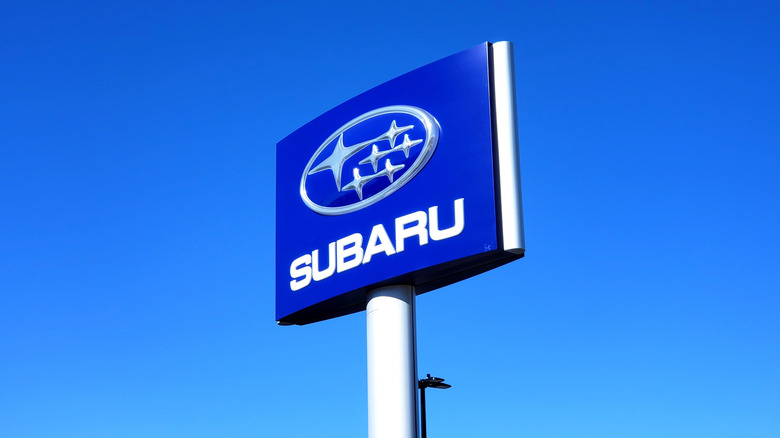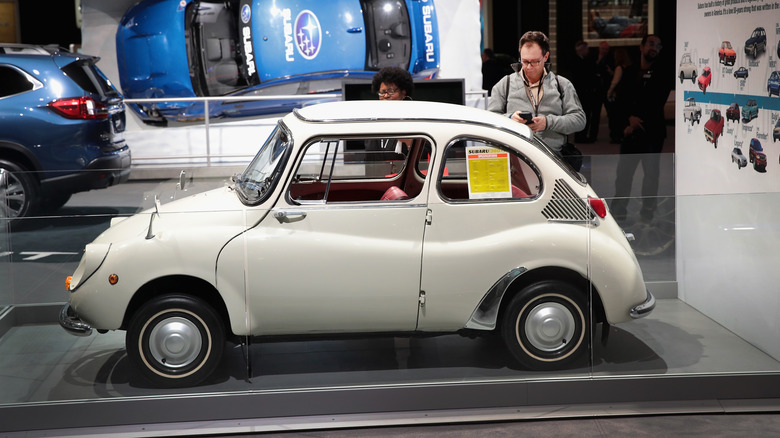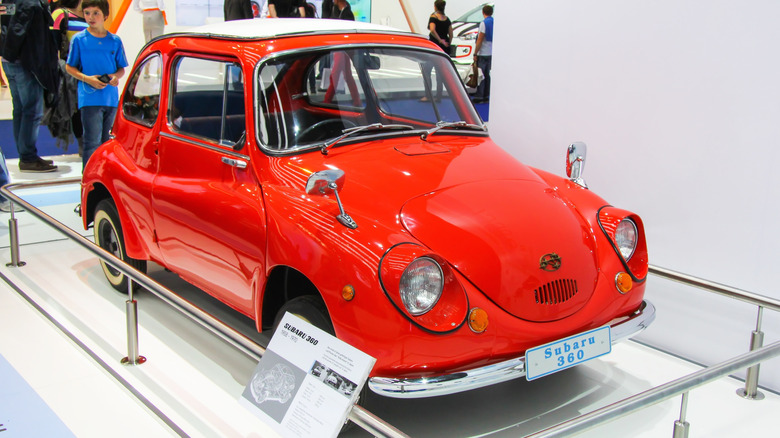When Did Subaru Enter The US And What Was The First Model It Sold In The Country?
What makes a Subaru a Subaru? According to the auto manufacturer, love, but good luck finding that in the bill of materials. Still, it's undeniable that many people do love their Subaru, and the Japanese brand has taken on a special significance within American car culture. Of course, there are the models associated with road trips and adventures, like the Subaru Outback, Crosstrek, and Forester. You may remember oddities and icons like the Subaru BRAT, or the discontinued Baja pickup. But what was the first Subaru to make its way stateside, and when did it land in America?
Today, Subaru vehicles are associated with reliability, safety, and practicality. Known for their capable all-wheel drive systems and plenty of storage space, the most successful Subaru models are those capable of facilitating a mountain getaway as easily as they get the kids to and from soccer practice. Downsize to the WRX, and you'll find a community of thrill-seeking gearheads who love to rally and race. And, of course, Subarus still retain a special significance to the LGBTQ+ community, thanks to some savvy marketing from a few decades ago.
But earning that stellar reputation was an uphill battle. The earliest Subarus Americans could buy were far from the polished products that now fill ski resort parking lots. Instead, what honked its way onto roads in the waning days of the mid-20th century was a budget car that was plagued by safety issues. Let's take a road trip to look at the humble beginnings of this now-beloved car brand. Here's what you should know about the first Subaru model in the United States.
Subaru of America was founded in 1968 by two businessmen
The first Subaru to land in America had more in common with a then-ubiquitous German import than it did with other cars on U.S. roads at the time. In 1968, two American entrepreneurs became convinced there was a domestic market for Subaru vehicles. Harvey Lamm and Malcolm Bricklin had no prior experience in the automotive industry, but incorporated the Subaru of America brand in mid-February of 1968 as an American-operated company located in Pennsylvania. This strategy was somewhat unique, as most automotive imports operated as subsidiaries of the foreign brand.
With everything in place but the vehicles themselves, it was time for Bricklin and Lamm to introduce the American public to a new range of Japanese vehicles. They decided to approach the market from an entry level. If Subaru couldn't make cars that outperformed American makes, it would instead target consumers looking for something easy and cheap. Volkswagen's first car sold in the US, the Beetle, had been enjoying massive success since it was first imported in 1949. That car took off in sales after its famous ad campaign with the slogan, "Think small." Moreover, by 1967, the Beetle had sold 320,692 units domestically, and nearly 2 million worldwide.
In 1968, Americans were able to get their hands on another imported car with a suspiciously Beetle-like body: The Subaru 360. While it's hard to prove any causal link between the Beetle's success and Subaru of America's first model, the similarities are striking. Compared to its German peer, though, the 360 was smaller, lighter, and most importantly, cheaper. Although it mostly flopped, it was the beginning of a trajectory that would lead the fledgling company to the successful brand we know it as today.
The Subaru 360 was the first to arrive in America, and it wasn't great
The first model of Subaru brought to market in America was the terrifyingly terrible Subaru 360. As a MotorTrend review of the classic vehicle put it in a 50th anniversary review, "Nothing is easy in a 1968 Subaru 360." CNN was even harsher that same year, calling it, "[O]ne of the worst cars ever sold in America." And, when it was first introduced, Consumer Reports called it "unacceptably hazardous." The rear-hinged doors wouldn't even stay closed.
Shaped somewhat like a much smaller, alarmingly anemic version of the Volkswagen Beetle, the Subaru 360 was as barebones as it gets. With a 25 horsepower, two-cylinder engine that boasted a top speed of about 50 mph and took the better part of a minute to get up to that speed, you might have been better off walking. Add to that its total lack of safety features — the bumpers were said to be useless, and there was barely a sheet of metal between the driver and the outside world — and you might be thankful it couldn't do highway speeds. In a world of big -bodied American cars, anyone driving a 360 was sure to suffer the brunt of a collision.
But the point of importing the 360 was not to compete with better cars. Instead, it was designed from the ground up to be extremely cheap — part of a growing class of kei cars in Japan that provided affordable, no-frills rides for commuters. Because it was so small and so threadbare, the 360 weighed just under 1,000 pounds. It was therefore not considered a car under American regulatory standards. It was priced at $1,300, several hundred dollars cheaper than other cheap cars like the Toyota Corolla.


